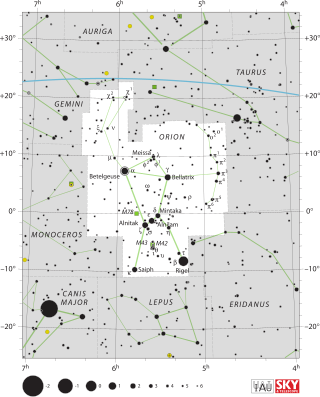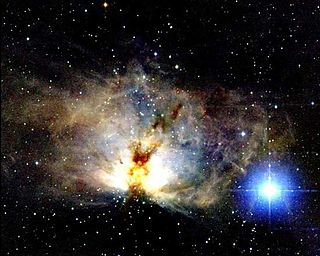Related Research Articles

Orion is a prominent constellation located on the celestial equator and visible throughout the world. It is one of the most conspicuous and recognizable constellations in the night sky. It is named after Orion, a hunter in Greek mythology. Its brightest stars are the blue-white Rigel and the red Betelgeuse.

Saiph, designation Kappa Orionis and 53 Orionis, is the sixth-brightest star in the constellation of Orion. Of the four bright stars that compose Orion's main quadrangle, it is the star at the south-eastern corner. A northern-hemisphere observer facing south would see it at the lower left of Orion, and a southern-hemisphere observer facing north would see it at the upper right. Parallax measurements yield an estimated distance of 650 light-years from the Sun, which is about the same as Betelgeuse. It is smaller, less luminous but hotter at its surface than Rigel with an apparent visual magnitude of 2.1. The luminosity of this star changes slightly, varying by 0.04 magnitudes.

Mintaka, designation Delta Orionis and 34 Orionis, is a multiple star system some 1,200 light-years from the Sun in the constellation of Orion. Together with Alnitak and Alnilam, the three stars form Orion's Belt, known by many names among ancient cultures. The star is located very close to the celestial equator. When Orion is near the meridian, Mintaka is the rightmost of the Belt's stars when viewed from the Northern Hemisphere facing south.

Alnilam is the central star of Orion's Belt in the equatorial constellation of Orion. It has the Bayer designation ε Orionis, which is Latinised to Epsilon Orionis and abbreviated Epsilon Ori or ε Ori. This is a massive, blue supergiant star some 2,000 light-years distant. It is estimated to be 832,000 times as luminous as the Sun, and 64.5 times as massive.

Bellatrix is the third-brightest star in the constellation of Orion, positioned 5° west of the red supergiant Betelgeuse. It has the Bayer designation γ Orionis, which is Latinized to Gamma Orionis. With a slightly variable magnitude of around 1.6, it is typically the 25th-brightest star in the night sky. Located at a distance of 250±10 light-years from the Sun, it is a blue giant star around 7.7 times as massive as the sun with 5.75 times its diameter.

Alnitak is a triple star system in the constellation of Orion. It has the designations ζ Orionis, which is Latinised to Zeta Orionis and abbreviated Zeta Ori or ζ Ori, and 50 Orionis, abbreviated 50 Ori. The system is located at a distance of several hundred parsecs from the Sun and is one of the three main stars of Orion's Belt along with Alnilam and Mintaka.

Iota Orionis is a multiple star system in the equatorial constellation of Orion the hunter. It is the eighth-brightest member of Orion with an apparent visual magnitude of 2.77 and also the brightest member of the asterism known as Orion's Sword. It is a member of the NGC 1980 open cluster. From parallax measurements, it is located at a distance of roughly 1,340 light-years from the Sun.

Meissa, designated Lambda Orionis is a star in the constellation of Orion. It is a multiple star approximately 1,300 ly away with a combined apparent magnitude of 3.33. The main components are an O8 giant star and a B-class main sequence star, separated by about 4″. Despite Meissa being more luminous and only slightly further away than Rigel, it appears 3 magnitudes dimmer at visual wavelengths, with much of its radiation emitted in the ultraviolet due to its high temperature.
Chi Orionis is the name of two stars:

Pi3 Orionis (π3 Orionis, abbreviated Pi3 Ori, π3 Ori), also named Tabit, is a star in the equatorial constellation of Orion. At an apparent visual magnitude of 3.16, it is readily visible to the naked eye and is the brightest star in the lion's hide (or shield) that Orion is holding. As measured using the parallax technique, it is 26.32 light-years (8.07 parsecs) distant from the Sun.

Pi Orionis is a group of fairly widely scattered stars in the constellation Orion that constitute the asterism Orion's Shield or Orion's Bow.

Tau Eridani is a group of fairly widely scattered stars in the constellation Eridanus.
The Bayer designation Omicron Canis Majoris is shared by two stars, in the constellation Canis Major:
The Bayer designation θ Orionis is shared by several astronomical objects, located near RA 05h 35m DEC −05° 24′:
The Bayer designation Phi Orionis is shared by two star systems in the constellation Orion.
Tau Orionis is a solitary star in the constellation Orion. If an imaginary line is drawn north-west between the stars Rigel and Mintaka, Tau Orionis can be found roughly one-sixth of the way to Mintaka. It is visible to the naked eye with an apparent visual magnitude of 3.58. Based upon an annual parallax shift of 6.6 mas, it is located around 490 light years from the Sun.

μ Orionis is a quadruple star system in the constellation Orion, similar to Mizar and Epsilon Lyrae with combined visual magnitude of 4.13. The four stars are known as Mu Orionis Aa, Mu Orionis Ab, Mu Orionis Ba, and Mu Orionis Bb. The A and B systems are several tenths of an arcsecond apart. The entire system is located approximately 150 light years from the Sun.
Omicron2 Orionis is a solitary star in the constellation Orion. It has an apparent visual magnitude of 4.06, which is bright enough to be seen with the naked eye. Based upon an annual parallax shift of 17.54 mas, it is around 186 light years from the Sun. At that distance, the visual magnitude of the star is diminished by an interstellar absorption factor of 0.09 due to intervening dust.

Theta2 Orionis is a multiple star system in the constellation Orion. It is a few arc minutes from its more famous neighbour the Trapezium Cluster, also known as θ1 Orionis.

UX Orionis is a variable star in the constellation of Orion. It is a Herbig Ae star, located about 1000 light years from the Earth. At its brightest it is a magnitude 9.5 object, so it is too faint to be seen with the naked eye. UX Orionis is the prototype of the UX Orionis class of variable stars, which are young stellar objects that exhibit large, irregular changes in visual band brightness. UX Orionis was discovered by Henrietta Swan Leavitt.